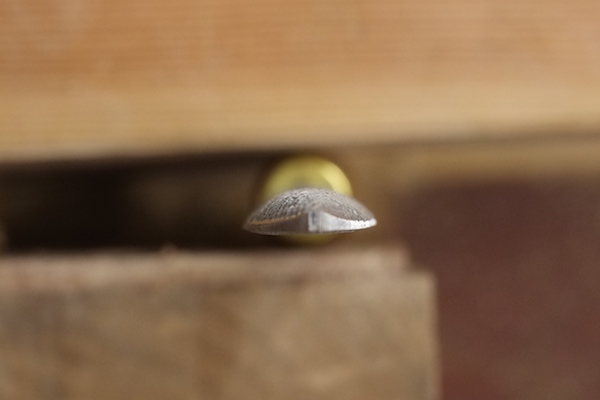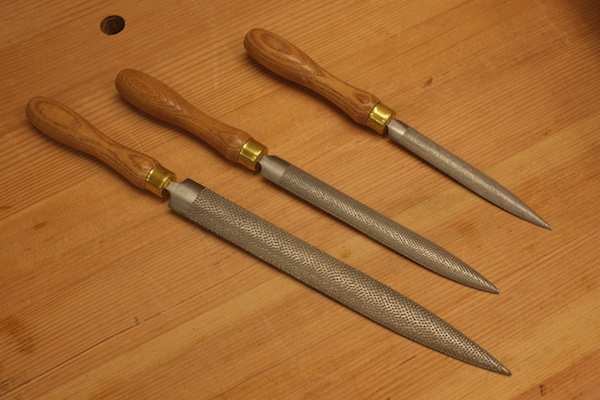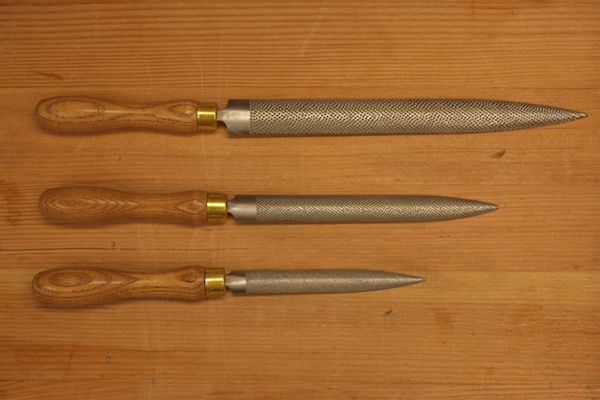A lot of woodworkers gravitate to Shaker-style projects, where the lines are straight and at right angles to each other, and for good reason. Not only do these sorts of projects have a clean look to them that fit well with our modern sense of style, but they also are relatively easy to make, since most of our woodworking tools are made for cutting wood in straight lines or at right angles.
So what do you do if you get tired of straight lines, and want to shape wood into curved forms? Rasps are one way to deal with this task. Today we will learn about what to look for in a rasp, and how to use them for shaping.

What are wood rasps?
A rasp is a tool used for shaping wood, and is distinguished by the many tiny sharp teeth that cover the surface of the rasp. Rasps can be classified into two types: machine-made, and handmade. Machine-made rasps have a very regular and even pattern to the teeth. This may seem desirable at first, but having the teeth of the rasp at very regular intervals leaves a pattern of deeper grooves in the wood that is more difficult to get out.
Handmade rasps, on the other hand, have teeth that are very slightly irregularly spaced, because the teeth are made by hand. You can see a video of this process here. This leaves a slightly random pattern to the teeth, resulting in a smoother surface. This is much like the difference between an orbital sander, where the sanding disc spins in a circle, and so it can leave circular marks on the surface of the wood, and a random orbit sander, where the disc mainly spins in a circle, but the random action reduces the amount of sanding marks on the wood.
Handmade rasps are more labor intensive to make than machine-made rasps, but the time you’ll save in sanding and scraping out the rasp marks makes handmade rasps worth the extra cost.
What kind of rasp is needed?
What kind of rasp you need depends on the task you have in mind. The shape of the rasp is one determining factor. For most furniture-sized projects, a cabinetmaker’s rasp is a good choice. The rasp has a flat side and a curved side. The flat side is good for working on the outside curve, or a convex face, of a project, while the curved side is good for working the inside of a curve, or a concave face. In the picture below, you can see the curved side on the top, and the flat side on the bottom.
 The profile of the round side of a cabinetmaker’s rasp limits how tight a curve can be shaped with that rasp. If you have more detail work to do, a modeler’s rasp might be useful. A modeler’s rasp also has a round and flat side like a cabinetmaker’s rasp, but it is smaller and the round side is often more curved, allowing it to be used in tighter places. A round rasp, also known as a rat tail rasp, is good for getting into very tight curves. There are many other shapes of rasps as well, some shaped for a particular task, like making saw handles or the stock of a rifle. The shape of a cabinetmaker’s rasp, a modeler’s rasp and a rat tail rasp can be seen in the picture below.
The profile of the round side of a cabinetmaker’s rasp limits how tight a curve can be shaped with that rasp. If you have more detail work to do, a modeler’s rasp might be useful. A modeler’s rasp also has a round and flat side like a cabinetmaker’s rasp, but it is smaller and the round side is often more curved, allowing it to be used in tighter places. A round rasp, also known as a rat tail rasp, is good for getting into very tight curves. There are many other shapes of rasps as well, some shaped for a particular task, like making saw handles or the stock of a rifle. The shape of a cabinetmaker’s rasp, a modeler’s rasp and a rat tail rasp can be seen in the picture below.

The same type of rasp can come in different lengths. A longer rasp means that you can take a longer stroke, and remove more wood with each stroke, but may be hard to use in tight spaces. Shorter rasps are nimbler, but will take off less wood with each pass.

Another factor is the size of the teeth. The larger the teeth, the more aggressive the rasp is in taking off wood, but with that speed comes a rougher surface. Smaller teeth are slower, but leave a smoother surface. Larger rasps tend to have larger teeth, but this is not a hard and fast rule. The difference between an aggressive rasp and a finer rasp can be seen below.

The size of the teeth on a rasp is often referred to as the grain, with lower grain numbers indicating coarser teeth, and higher grain numbers indicating smaller teeth. There seems to be no standard way, however, of indicating the size of rasp teeth between manufacturers, so it is probably worth contacting the makers for their recommendations as to the grain size or tooth size most suitable for your needs.
Finally, handmade rasps are set up to be used by right-handed or left-handed people. Make sure the rasp you get is suitable for your handedness.
A good starter set of rasps is to get a larger cabinetmaker’s rasp with coarse teeth for quick removal of wood, a smaller cabinetmaker’s rasp with finer teeth for refining the surface and a small modeler’s or rat tail rasp with very fine teeth for detail work. Again, handmade rasps will give you better results than machine-made rasps, so don’t let the extra expense scare you off.

Next time, we will learn how to use rasps to quickly shape wood to the form that you want.

Share tips, start a discussion or ask one of our experts or other students a question.
No Responses to “Top Tips for Choosing and Using Wood Rasps”